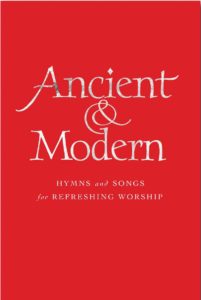My copy of Ancient & Modern: Hymns and Songs for Refreshing Worship (2013) has just arrived. It is the ninth edition of what is the most enduring and popular lineage of hymnals in the Church of England. We currently use Common Praise (2000, the eighth edition of A&M), in the College Chapel. My former churches have used Sing Glory (1999), Ancient & Modern New Standard Edition (1983) and New English Hymnal (1986) as their main hymnbooks, which is progress of sorts! Unlike some churches, the Church of England has never had an official hymnbook, but the Ancient & Modern stable comes closest to a standard.
For some background and a couple of thoughts about hymnals in the 21st century, see Ancient & Modern: history and future.

Ancient & Modern has 847 items: the largest inventory in this hymnbook’s history, beating the 779 hymns of the Standard Edition (1916 & 1920). Not all of these are hymns, some are liturgical songs and ‘short chants’. It is not too much of a surprise that this is an increase on the 628 hymns of Common Praise. However, seeing that the intermediate supplement Sing Praise (2010) has 330 entries, there has been a bit of a cull. I guestimate that around 150 hymns in Common Praise have been cut (inexplicably, the cloying ‘In a world where people walk in darkness’ (CP 476, AM9 677) has survived!). I confess to some alarm that so many hymns that were thought necessary of inclusion 13 years ago have proved disposable. It makes me wonder how many in the current
Physically, the full-music editions of the two hymnals, eighth and ninth editions, are about the same size. Although this is perhaps due to my old Common Praise being stretched with use, the paper used for the ninth edition is clearly thinner, yet this has
It would take 2½ years to sing through all 847 items without repeating one, given four hymns every Sunday morning and three in the evening. Of course, there are always going to be some hymns that are not to the taste of clergy, musicians and congregations, and others that are repeat favourites. Some of the liturgical items might be used week in, week out, or not at all.
The arrangement of the hymns follows the tried and tested pattern of the A&M stable: the diurnal of morning and evening, the seasons of the church year, saints’ days, a few service themes and the lucky dip of ‘Hymns throughout the Year’ (the odd name of the category used in Common Praise) or ‘General’ (the more sensible title in the ninth edition). The ninth edition’s categories are a joy: after the saints’ days, there are decent selections of hymns for Christian initiation, marriage, and funerals and the departed. Then there are selections of hymns chosen for use in a generalised sequence of sections of church services: gathering, penitence, the word of God, canticles and affirmations of faith, prayer and intercession, Holy Communion, and sending out. These mix hymns with liturgical texts, like the three modern Kyries (370–2) in the penitence category; the first is that from James MacMillan’s Mass of the Blessed John Henry Newman. The word category begins with the traditional sixth-mode Alleluia (374), and goes on to provide an Alleluia setting by Bernadette Farrell (376) and James Walsh’s Pilgrim’s Alleluia (377) — I am left to wonder why the Stanbrook Abbey hymn ‘Bright as fire in darkness’ intrudes at 375. There is also a Marty Haugen song that can be used as an Alleluia at 385, demonstrating the problem that items are arranged mainly in alphabetical order within categories rather then rational groupings. Thankfully the metrical Magnificats and other canticles are grouped together. The category for prayer and intercession includes a number of simple, modern chants that can be used as sung responses to supplications. It is not necessarily obvious, but four metrical settings of Gloria in excelsis Deo (413–16) are in the Holy Communion category, followed by two settings of Sanctus (417, 418) and one Agnus Dei (419). The 61 items in this category could really have done with a finer level of grouping within the category.
The later categories of themes — the church’s ministry and mission, wholeness and healing, sorrow and lament, creation and the environment, justice and peace, and national and remembrance — are welcome, if still slightly thin. Even with all of these categories, there are still 246 ‘general’ hymns (29 % of the inventory). Still, this is an improvement on the like category of 265 hymns in Common Praise (42 %). There are hymnals, like Mission Praise, Sing Glory and Hymns Old & New, that take the unimaginative approach of arranging all their entries in alphabetical order of their textual incipits (though I do remember some old copies of Mission Praise took a unique approach to the alphabet!). Given a decent index, and the ninth edition has indexes aplenty (read on if you, like me, sadly spend more time in hymn indexes than with the hymns themselves), it makes sense to organise things by sensible categories and relationally. Thus, I am sure the compilers saw the need to keep the lucky dip to a minimum, recognising it as a sign of methodological laxity. A rough grouping of these hymns by theological themes would have been a welcome change, alongside better grouping of items within the other categories. The group of 17 ‘short chants’ at the end, mostly from Taizé and Iona, alongside some in other categories, will be a welcome addition in many churches.
The indexes include the now standard and practical parade of biblical index, hymn suggestions for each Sunday and major feast, alphabetical index of tunes, metrical index of tunes, index of composers, index of authors, and the index of first lines and tunes. Alongside these there is a list of hymns ‘suitable for all-age worship’ that some might use, but also a particularly handy thematic index that lists hymn numbers appropriate to a wide range of theological and other themes. Some of these (e.g. marriage) exactly reproduces a category, adding the belt to the braces. Yet this extra index shows an appropriate response to the problem of categories: what to do with those items that fit multiple categories. It also allows for themes that are too vague to have been categories (e.g. water).
The influence of Hymns Old & New (first Anglican Edition in 1986, with the popular New Anglican Edition a decade later, now superseded by others) can be seen in the ninth edition. Although Hymns Old & New has had major flaws in its musical arrangements and production quality, it brought together favourite hymns with choruses, praise songs and chants. Its coup was to provide what many churches wanted. Starting with Sing Praise, the Ancient & Modern tradition began to incorporate this wider repertoire, and the ninth edition includes symbols for guitar chords above the music for some items, thankfully not following Hymns Old & New in providing them for all items, even where they conflict with the musical arrangement.
For controversialists, Stuart Townend and Keith Getty‘s ‘In Christ alone my hope is found’ is included (678), with its words ‘the wrath of God was satisfied’ in the second verse. Whereas some have rewritten the line, Getty has, understandably, refused to allow it to be used with an altered text. While American Presbyterians have recently decided to omit the hymn because of that line, it now makes Ancient & Modern look doctrinally brave/timid for including it.
For some background and a couple of thoughts about hymnals in the 21st century, see Ancient & Modern: history and future.



